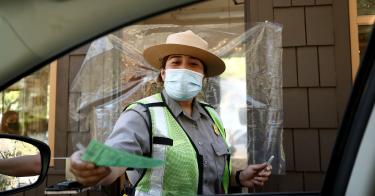Several national parks, closed for more than two months because of coronavirus pandemic, are now reopening. Even with restrictions in place, nature lovers are looking forward to visiting these national treasures this summer. In Washington, policymakers are trying to improve the visitor experience by addressing the enormous maintenance backlog at the parks.
The National Park Service manages acreage four times the size of Pennsylvania, and most every human-made thing on those lands—such as roads, bridges, sewer systems, trails and visitor centers—is in need of repair. The Interior Department estimates the cost of eliminating the park system’s deferred maintenance backlog at $12 billion. Add in all other public lands, and the price tag balloons to $20 billion.
Deferred maintenance not only detracts from the park experience, it also creates environmental liabilities. For example, Holly Fretwell, a research fellow at the Bozeman-based Property and Environment Research Center, noted that broken wastewater systems had polluted streams in Yosemite and Yellowstone national parks.
Growing visitation and aging infrastructure are two reasons why the backlog is so large; misaligned political incentives are another. It’s more appealing for lawmakers to cut a ribbon at a new trailhead than to appropriate money to fix leaky toilets.
But lawmakers are now trying to tackle the problem. The Senate will soon vote on the Great American Outdoors Act, which would establish a National Parks and Public Land Legacy Restoration Fund dedicated to addressing the maintenance backlog. Fees from energy producers working on public lands would fill the fund with up to $1.9 billion annually for the next four years.
>>> Tackling the Enormous Deferred Maintenance Backlog for America’s National Parks
Relying on energy production revenues has its pros and cons. On one hand, tying park maintenance to energy production creates stronger incentives to return to the guiding principles of multi-use land. Ranchers, farmers, tourists, hunters, and other individuals and groups have an interest in how the feds manage the land. Tethering energy revenues to improving our parks could open access to the abundance of resources on federal lands and in federal waters.
Conversely, overly restrictive policies on energy production would reduce the funds available. Some lawmakers want a total moratorium on fossil-fuel extraction from federal lands. A drilling ban may not affect revenues for a while, but if the fund becomes a more permanent fixture in addressing deferred maintenance, moratoria would seriously deplete the revenue stream.
The bill, while well-intentioned, also has some problems. It would restructure the Land and Water Conservation Fund (LWCF) as a mandatory spending program. The LWCF is the federal government’s primary mechanism for acquiring more land. The bill gives the executive branch a green light to use this fund to acquire more land in perpetuity.
Thus, in almost in the same breath, the act seems to say: We have so much federal land that we’ve been unable to keep it up, yet we’re going to put the program used to buy more land on autopilot with minimal accountability.
The federal government already owns roughly 640 million acres—almost 30% of the country and nearly half of the West. Shrinking the federal footprint would deliver better economic and environmental outcomes.
Another problem with the bill is that it does not offset spending. In an era of trillion-dollar deficits, deficit neutrality should be a bare minimum. There are other ways to reduce the maintenance backlog without breaking the bank. Raising park fees is one option. Charging higher fees for international visitors, who don’t pay U.S. taxes, is another.
Yet another option is privatizing unwanted federal lands. This would bring in cash and reduce the amount of acreage the feds need to tend after.
It’s encouraging to see the deferred maintenance backlog receive the congressional attention it deserves. But policymakers would be wise to take the fiscal and federal land acquisition concerns into account and use this opportunity to offer alternative revenue sources to tackle the backlog.
This piece originally appeared in The Washington Times




